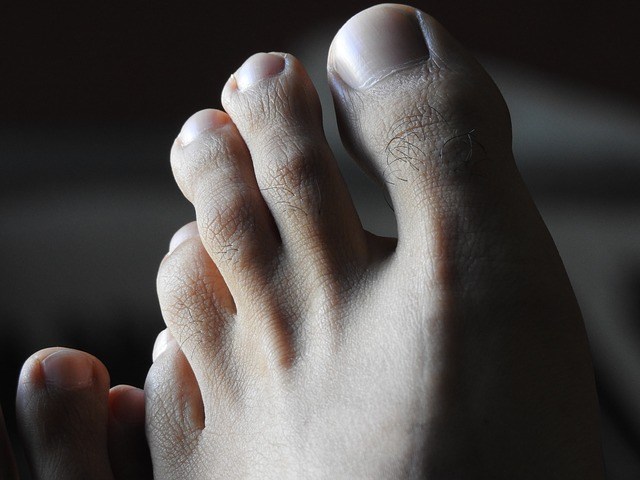Feet are funny. On average, your feet hold a quarter of the bones in your body, contain 8,000 nerves, and will carry you over 100,000 miles in your lifetime.
Taking care of your feet is something more of us should do – just in case you need a convenient excuse to book that foot massage, and your toenails are included in that luxury treatment.

Pedicures are fun and all, but sometimes more serious treatments are needed for combating thick, yellow toenails.
Thick toenails, though it may surprise you, are a sign that something might be wrong with your feet.
Although we all want thicker, stronger nails, as they’re less likely to break and should indicate good health, when they become too thick – this is a sign of trouble.
By paying attention to what your feet are saying, you can nip a problem in the bud.
Contents
Thick Toenails: What Causes Them?
There are a few causes of thick toenails. We’ll go through each of them, and talk about treatment and preventative steps you can take.
First up…
Aging
The human body was not designed to last forever, and sparkly-skinned, immortal vampires are a thing of fiction.
As we age, our nails grow slower and slower, causing the nail cells to accumulate over time, which in turn causes the nails to thicken. It’s just a fact of life, unfortunately.
There is little that one can do to prevent ageing from affecting your toenails, aside from discovering the fountain of youth, but any pedicurist worth their salt can buff the nail and smooth out the appearance.
Injury and Repeated Trauma
Stubbing your toe results in the use of swear words. Repeated trauma to your toes can result in toenails thickening over time, kind of like scar tissue or calluses building up.
Certain people are more at risk of developing thick toenails from repeated trauma, like dancers and athletes. Wearing ill-fitting shoes consistently will do this too.
Obviously, buying well-fitted shoes can help prevent thickening toenails – giving your little toes some room to breathe!
Sports-related injuries can be mitigated by wearing proper gear and seeing a foot specialist on the regular, to catch any issues before they become problems.
As this issue is a result of trauma, prevention really is the best cure; however investing in proper nail care, and perhaps a few trips to a pedicurist, will help control the thickening.
Fungal and Yeast Infections
Most of the time, what causes thick toenails and yellowing in the nail are fungal or yeast infections.
They are more common than most people think, and can go undetected for weeks, months, and or even years. Onychomycosis is one of the most common causes of thick toenails.

Fungal infections themselves can spring up easily. So easily, in fact, that 20% of adults develop one at some point in their lives.
The signs of a fungal infection include:
- A foul odor from the toenail.
- Loose toenails that lift from the bed.
- Changes in the color of the nail (yellow, brown, or green).
- Splitting or crumbling of the nail.
- Chalky or scale-like build–up on the nail.
- Dirt, debris, or dark growths under the nail.
What causes infections like onychomycosis?
Constricted or damp footwear, athlete’s foot spreading to the toenail, smoking, exposure to damp areas (like bathrooms and locker rooms), and damaged nails.
Preventing fungal and yeast infections is pretty simple: wear appropriately-sized footwear, treat any injuries to nails with disinfectant, keep your shoes dry, and avoid walking barefoot in public restrooms and showers.
Treatment will likely require a doctor’s input, especially if you haven’t had a fungal infection before.
There are other, more serious, medical problems that can cause yellow or thickening toenails, like diabetes. However, most fungal treatments will require prescription creams or ointments, medication, complete removal of the nail, and laser therapy.
Fungal treatments, too, require weeks, sometimes months, of said treatment. It’s best to get onto a treatment plan as soon as possible.
The longer infections like these go on, the harder they become to treat.
Skin Conditions
Skin conditions like psoriasis and paronychia can spread, causing flaking, yellowing, pitting, and thickening of the nails.
It’s likely that, if you have one of these conditions, you’ll already know to keep watch for changes in your nails.
Thick toenail treatment for these issues will relate to whatever your doctor prescribes as a treatment for the skin condition.

There aren’t many preventative measures one can take if it is a skin condition causing thickening toenails.
However, those with paronychia could attempt to avoid careers that involve touching chemicals or submerging their hands in water, like bartenders, dishwashers, cleaners, and nurses.
Overall
So, if you notice your toenails thickening or gaining a yellow tinge…don’t panic! Just head to the doctor and stick your foot in their face.
The causes of thick toenails are hardly dire, and, for the most part, can be easily treated!
Do you have any tips for dealing with thick toenails?

